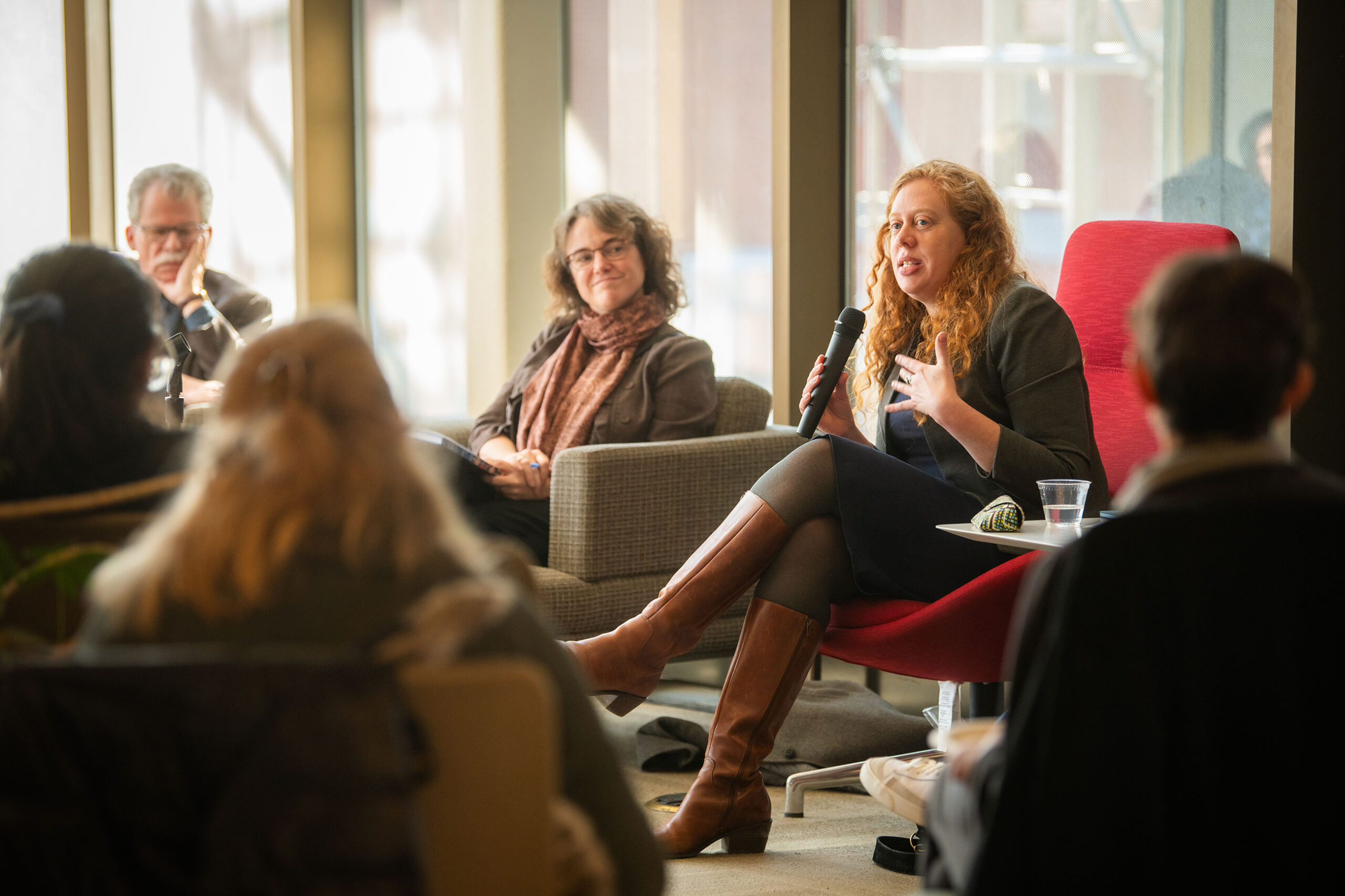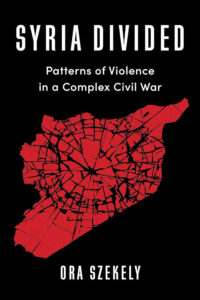How did combatants’ narratives and social media shape Syria’s civil war?

Clark political scientist Ora Szekely admits she has ignored the advice she learned in graduate school at McGill University: Don’t write books about current events; they are “moving targets,” ever evolving and slippery to predict by the time a publication date rolls around.
To that point, she gave a talk on Feb. 7 for Goddard Library’s “Between the Lines: A Clark Author Series,” about her most recent book, “Syria Divided: Patterns of Violence in a Complex Civil War” as another Middle East conflict, this time between Israel and Hamas, raged in Gaza. Szekely’s first book, “The Politics of Militant Group Survival in the Middle East: Resources, Relationships, and Resistance” (2017), covers the long-standing Arab-Israeli conflict and the roles of four non-state actors: the PLO, Hamas, Hezbollah, and Amal.
Yet, as she presciently wrote in 2022, the Syrian war — in which combatants extensively shared their “performative violence” on social media and often successfully communicated their narratives to the world — “may well represent a template for the future of warfare, or at least, provide a preview of what may be a feature of many wars in the future. The ongoing war in Ukraine, for instance, has been heavily documented on TikTok and Twitter.”
“I felt like I had to write a book about Syria. It felt so tremendously important, and the suffering of the Syrian people was so extraordinary.”
— Professor Ora Szekely
Szekely became interested in studying the Middle East after learning Arabic as an undergraduate at Cornell and serving as a Peace Corps volunteer in Jordan. For her doctoral research at McGill University in Quebec, she traveled throughout the Levant to better understand the resilience and interconnected histories of the non-state actors in the Arab-Israeli conflict and their role in shaping local and regional political narratives, the subject of her first book.
In 2011, as she sequestered herself in Canada to finish her dissertation, the Arab Spring uprisings erupted. Starting with the self-immolation of a street vendor in Tunisia in December 2010, the revolutionary fervor spread to Libya, Egypt, Yemen, Syria, and Bahrain.
“It was kind of surreal. I was spending 10 to 12 hours a day writing, and I would have Al Jazeera on in the background on my laptop,” watching people take to the streets in pro-democracy protests, says the associate professor of political science.
Along with the rest of the world, she watched protesters’ self-made videos of the uprisings on Facebook, Twitter, and YouTube. “That is when we first saw how activists began to discover the potential of social media platforms to highlight what was happening to them,” she says.
When President Bashar al-Assad turned his full military might against pro-democracy protesters and other civilians in Syria, and the crisis had evolved into a full-scale civil war in 2012, she could not ignore what was happening.
“I felt like I had to write a book about Syria. It felt so tremendously important, and the suffering of the Syrian people was so extraordinary. It felt like the most urgent crisis facing the region,” says Szekely, who last visited the country in 2009.
Listen to an interview with Ora Szekely (2022)
As of today, more than 600,000 people have been killed in the Syrian civil war, according to the International Committee of the Red Cross and Red Crescent Movement, and the conflict “remains the largest displacement crisis in the world, with more than 12 million Syrians forcibly displaced in the region,” according to the U.N. Refugee Agency. Most now live in Turkey, Lebanon, and Jordan, with the rest mainly settling in Germany and other European countries. Nearly 10,000 Syrians ended up in the U.S.
“Trying to understand how this had possibly happened, and why the war was just so extraordinarily vicious, felt really important to understand,” says Szekely, who plans to donate royalties from her book to organizations helping Syrian refugees.
‘Civil wars are rarely ‘about’ just one thing’
“Syria Divided” explores the multiple, competing narratives of state and non-state actors involved in Syria’s civil war. “Civil wars are rarely ‘about’ just one thing,” Szekely writes, and they “rarely take the form of a simple two-sided fight between ‘the government’ and ‘the rebels’ over a clearly articulated and agreed upon point of contention.”
 In her talk at Goddard Library, Szekely summarized which groups are involved and aligned in Syria’s civil war, now stalemated and approaching its 13th year on March 15.
In her talk at Goddard Library, Szekely summarized which groups are involved and aligned in Syria’s civil war, now stalemated and approaching its 13th year on March 15.
In power officially since 1970, the Assad regime — members of the Alawite minority ruling a majority-Sunni Muslim country — is backed by Russia and Iran, which in turn supports participation by Hezbollah, the Shiite military group from Lebanon.
The opposition, she says, includes “this whole basket of groups that actually don’t necessarily like each other or even cooperate with each other very much”: soldiers who defected from the Syrian military; jihadist factions funded by state and private donors in the Gulf; and ISIS, which started as a branch of Al Qaeda in Iraq and later recruited Syrian fighters, perpetrated genocide against Yazidi Kurds, and published beheading videos, mostly of Iraqis and Syrians but also of Westerners. Attempting to counteract ISIS, the Obama administration began backing the Kurds in northern Syria.
In the Arab Spring and Syrian war, Szekely found the role of social media — and especially YouTube — “genuinely surprising,” and she explores the phenomenon in her book. Young activists were the first to use YouTube to document their pro-democracy protests.
“There were a lot of people who quickly turned themselves into citizen journalists, running toward a government air strike with their phones out, filming landmarks and yelling out the dates, so they could send the video to journalists or put it on YouTube themselves to try and expose what’s happening in Syria,” she says.
“That’s the use of social media that’s most familiar to us, the idea that you can use social media to document what’s happening when the international media maybe doesn’t care about it, or when your government is trying really hard to suppress media coverage by killing or arresting journalists,” she adds. “But the other thing that we see is it’s not just the civilian activists who are using social media, it’s also the combatants.”
“When you look at the history, a country that is around five thousand or seven thousand years does not get ruined in ten years.”
— Anonymous Syrian
The smaller rebel factions began to use social media to “speak” to private donors outside Syria to raise funds for weapons. They competed for the donors’ attention through “performative violence,” filming blow-ups of tanks and exchanges of fire against opposing groups.
Yet, Szekely points out, “most of the actors fighting in Syria did not have a cohesive, strategic approach to social media, partly because they didn’t actually have a cohesive approach to military strategy.”
In 2024, that has changed. “If we look at asymmetric warfare around the world, we see social media being used so commonly that I think a lot of governments and non-state actors are starting to realize, ‘We need to have some kind of policy on this. We need to figure out how we’re going to use this, what this is going to mean for us.’ ”
In researching her book, Szekely interviewed nearly 50 people, including, she writes, “activists, journalists, defectors from the regime’s military and security services, former political prisoners, former members of the armed opposition, and many ordinary Syrians,” many of whom want to return home but realize they never may. For reasons of safety, they remain anonymous.
“Syria Divided” concludes with their thoughts and speculation “as to what the next decade or so might hold.” Some expressed hope; others, pessimism. Many spoke of their compatriots’ and Syria’s resilience.
“When you look at the history,” one Syrian says, “a country that is around five thousand or seven thousand years does not get ruined in ten years.”


